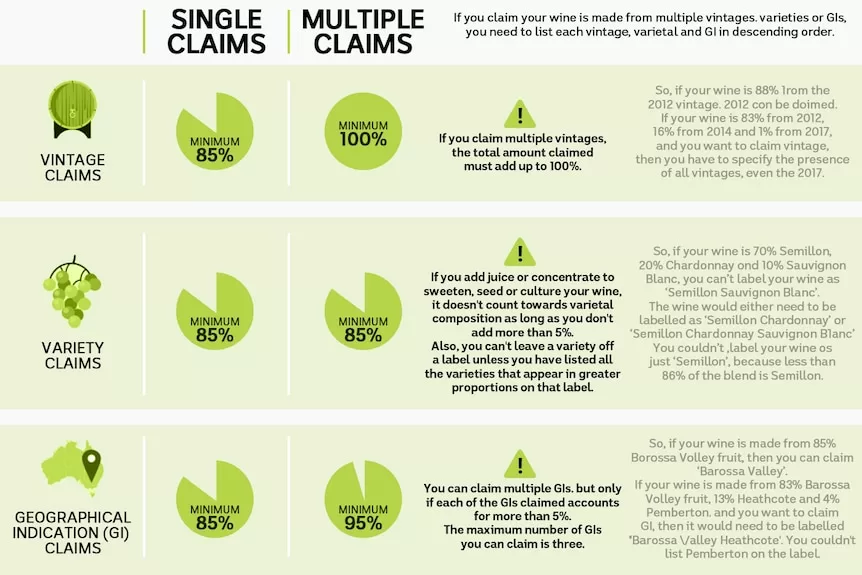I once read that former cricket commentator Tony Greig had a theory about buying wine.
It was along the lines of: “If in doubt, get a red from South Australia. It’ll be fine.”
Whether it’s true or not, that line has stuck with me and influenced my own wine purchases, and is probably why I can’t stop thinking about the Two Churches Shiraz example from the Four Corners supermarket exposé.
In case you missed it, here it is.
A mid-priced bottle of red wine with a Barossa story is something I would buy — fully expecting it to be from the Barossa Valley.
But the address on the back of the bottle was Hawthorn East, Victoria, and as fifth-generation Barossa grape grower Adrian Hoffmann explained to Four Corners …
“It sounds like a Barossa story, but you can’t be guaranteed it’s Barossa fruit, unfortunately,” he said.
After questions from Four Corners, references to the Barossa were removed from Coles’ websites promoting the wine.
So what are the rules?
Australia’s wine industry has a legislated Label Integrity Program (LIP), which is designed to ensure the truth “and the reputation of truthfulness” of statements made on wine labels.
The three major claims protected by the LIP are vintage, variety, and geographical indication.
It is not mandatory to make these claims on a bottle of wine.
However, if a claim is made, then an “auditable trail of records must be available” to substantiate it.
The rules for the “geographical indication” on a wine label is that a minimum of 85 per cent of the grapes used to make the wine must come from the location on the label.
So for example, the Two Churches Shiraz aired on Four Corners showed a bottle that seemed to have a Barossa story on the back of the label and “South Australia” written on the front.
This means the wine must be made from at least 85 per cent fruit sourced from anywhere in South Australia.
If the wine contains zero grapes from the Barossa Valley, that would be fine according to the LIP.
Chief executive of Australian Grape and Wine, Lee McLean, said consumers wanted and deserved to have clarity about what they were buying.
“I think the system works well,” he said.
“Where there might be an area of concern for consumers is when [wines] use stories about particular sites … that might fall outside the label integrity program.”
“[But] while this may not be captured by the LIP, there is the potential for such stories to be misleading under consumer law.”
What are the penalties?
According to Wine Australia’s website, companies risk serious penalties if they make a false record, or fail to verify a claim about vintage, variety, or geographical indication.
“A maximum penalty of two years’ jail, or a fine of 120 penalty units instead of or additional to imprisonment, applies for each offence,” it said.
“Failing to comply with the LIP could also result in export licence cancellation or suspension, or your products being withdrawn from the market.”
Wine Australia said there was “a strong culture of compliance” within the industry, with just six licences cancelled or suspended for LIP breaches between 2016 and 2020.
What do growers think of these rules?
Victorian-based winemaker Cameron Wilson, said the labelling on some wines was misleading.
“This half-smart labelling is just rotten,” he said.
“It fleeces shoppers, it screws producers, and can devalue the produce of entire regions.
“They should just label a product as what it is, and stop looking for loopholes to mislead us.”
Loading…
Owner of Stonier Wines on the Mornington Peninsula, Aaron Drummond, said labels “pretending to be a wine of place” was a massive issue.
“There are lots of examples on the shelves at the moment where brands reference places on the Mornington Peninsula as part of their brand or label story, yet the wine is not from here,” he said.
“Instead [the grapes] come from high cropping regions often in other states [and] the quality is simply not the same.”
He said the cost of growing pinot noir in his region was over $4,500 a tonne, translating to a bottle price generally above $40.
“So if you think you are buying a bottle of Mornington Peninsula pinot noir for under $20, you are not. It’s just not possible to grow and make wine here for that price” he said.
“Even under $30, I would check the label very carefully. If it doesn’t say Mornington Peninsula wine, then it isn’t from here.”
Watch ABC TV’s Landline at 12:30pm on Sunday or on ABC iview.
